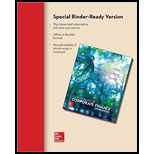
Fundamentals of Corporate Finance (Special Edition for Rutgers Business School)
11th Edition
ISBN: 9781308509853
Author: Ross, Westerfield, Jordan
Publisher: McGraw Hill
expand_more
expand_more
format_list_bulleted
Question
Chapter 5.2, Problem 5.2ACQ
Summary Introduction
To discuss: The meaning of
Introduction:
The value of dollar at present will not be the same as the value of dollar earned in the future. The value of money deteriorates as the years pass by. Hence, the present value of money is different from the
Expert Solution & Answer
Want to see the full answer?
Check out a sample textbook solution
Students have asked these similar questions
What is the formula for calculating the present value of a future cash flow, and why is discounting used in finance?
What is the formula for calculating the present value of a future cash flow, and why is discounting used in finance? Expla
Explain the difference between systematic risk and unsystematic risk. How can an investor reduce unsystematic risk in their portfolio?need help!
Chapter 5 Solutions
Fundamentals of Corporate Finance (Special Edition for Rutgers Business School)
Ch. 5.1 - Prob. 5.1ACQCh. 5.1 - Prob. 5.1BCQCh. 5.1 - Prob. 5.1CCQCh. 5.2 - Prob. 5.2ACQCh. 5.2 - Prob. 5.2BCQCh. 5.2 - What do we mean by discounted cash flow, or DCF,...Ch. 5.2 - Prob. 5.2DCQCh. 5.3 - Prob. 5.3ACQCh. 5.3 - Prob. 5.3BCQCh. 5 - You deposited 2,000 in a bank account that pays 5...
Ch. 5 - Prob. 5.2CTFCh. 5 - Charlie invested 6,200 in a stock last year....Ch. 5 - Prob. 1CRCTCh. 5 - Compounding [LO1, 2] What is compounding? What is...Ch. 5 - Prob. 3CRCTCh. 5 - Compounding and Interest Rates [LO1, 2] What...Ch. 5 - Prob. 5CRCTCh. 5 - Prob. 6CRCTCh. 5 - Prob. 7CRCTCh. 5 - Prob. 8CRCTCh. 5 - Prob. 9CRCTCh. 5 - Prob. 10CRCTCh. 5 - Prob. 1QPCh. 5 - Prob. 2QPCh. 5 - Calculating Present Values [LO2] For each of the...Ch. 5 - Calculating Interest Kates [LO3] Solve for the...Ch. 5 - Prob. 5QPCh. 5 - Calculating Interest Rates [LO3] Assume the total...Ch. 5 - Prob. 7QPCh. 5 - Calculating Interest Rates [LO3] According to the...Ch. 5 - Calculating the Number of Periods [LO4] Youre...Ch. 5 - Prob. 10QPCh. 5 - Prob. 11QPCh. 5 - Prob. 12QPCh. 5 - Calculating Interest Rates and Future Values [LO1,...Ch. 5 - Calculating Rates of Return [LO3] Although...Ch. 5 - Prob. 15QPCh. 5 - Prob. 16QPCh. 5 - Calculating Present Values [LO2] Suppose you are...Ch. 5 - Prob. 18QPCh. 5 - Calculating Future Values [LO1] You are scheduled...Ch. 5 - Prob. 20QP
Knowledge Booster
Similar questions
- Explain the difference between systematic risk and unsystematic risk. How can an investor reduce unsystematic risk in their portfolio?arrow_forwardA firm has a project with an initial investment of $100,000 and cash inflows of $30,000 per year for 5 years. If the firm’s required rate of return is 10%, should the project be accepted based on its net present value (NPV)? Need helparrow_forwardA firm has a project with an initial investment of $100,000 and cash inflows of $30,000 per year for 5 years. If the firm’s required rate of return is 10%, should the project be accepted based on its net present value (NPV)?arrow_forward
- Define capital structure. What are the main factors that influence a company's decision on how much debt versus equity to use? Exparrow_forwardDefine capital structure. What are the main factors that influence a company's decision on how much debt versus equity to use?arrow_forwardAns A company has a beta of 1.2, the risk-free rate is 3%, and the expected market return is 8%. Using the Capital Asset Pricing Model (CAPM), calculate the expected return on the company's stock. Need help !!!arrow_forward
- A company has a beta of 1.2, the risk-free rate is 3%, and the expected market return is 8%. Using the Capital Asset Pricing Model (CAPM), calculate the expected return on the company's stock.arrow_forwardA firm issues a preferred stock with a dividend of $6 per year. If the market price of the preferred stock is $80, what is the cost of preferred equity for the firm?arrow_forwardGive answer.Explain the difference between a primary market and a secondary market. Why are both important in financial markets?arrow_forward
- Explain the difference between a primary market and a secondary market. Why are both important in financial markets? Need help!!arrow_forwardQuestion: A company has issued a bond with a face value of $1,000, a coupon rate of 5%, and a maturity of 10 years. If the bond is currently trading at $950, what is the bondholder's yield to maturity (YTM), and how does it differ from the coupon rate? need help!!arrow_forwardA company has issued a bond with a face value of $1,000, a coupon rate of 5%, and a maturity of 10 years. If the bond is currently trading at $950, what is the bondholder's yield to maturity (YTM), and how does it differ from the coupon rate?arrow_forward
arrow_back_ios
SEE MORE QUESTIONS
arrow_forward_ios
Recommended textbooks for you
- Principles of Accounting Volume 2AccountingISBN:9781947172609Author:OpenStaxPublisher:OpenStax College
 EBK CONTEMPORARY FINANCIAL MANAGEMENTFinanceISBN:9781337514835Author:MOYERPublisher:CENGAGE LEARNING - CONSIGNMENT
EBK CONTEMPORARY FINANCIAL MANAGEMENTFinanceISBN:9781337514835Author:MOYERPublisher:CENGAGE LEARNING - CONSIGNMENT

Principles of Accounting Volume 2
Accounting
ISBN:9781947172609
Author:OpenStax
Publisher:OpenStax College

EBK CONTEMPORARY FINANCIAL MANAGEMENT
Finance
ISBN:9781337514835
Author:MOYER
Publisher:CENGAGE LEARNING - CONSIGNMENT
